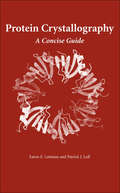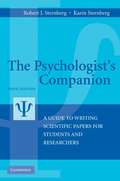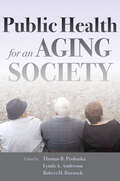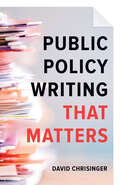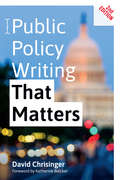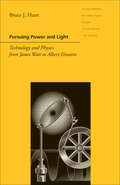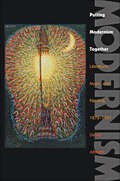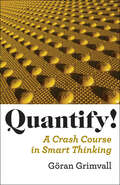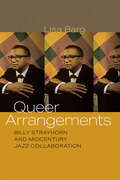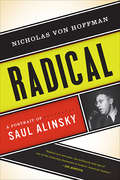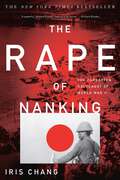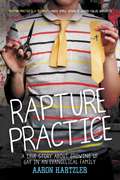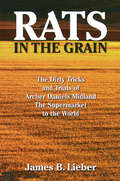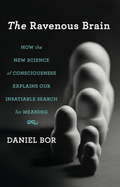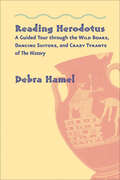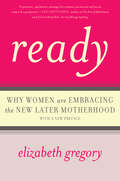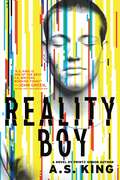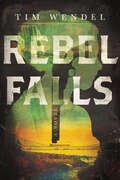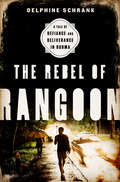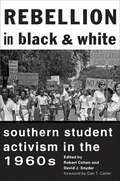- Table View
- List View
Protein Crystallography: A Concise Guide
by Eaton E. Lattman Patrick J. LollThe proteome remains a mysterious realm. Researchers have determined the structures of only a small fraction of the proteins encoded by the human genome. Crystallography continues to be the primary method used to determine the structures of the remaining unknown proteins. This imaging technique uses the diffraction of X-rays to determine a protein’s three-dimensional molecular structure.Drawing on years of research and teaching experience, Eaton E. Lattman and Patrick J. Loll use clear examples and abundant illustrations to provide a concise and accessible primer on protein crystallography. Discussing the basics of diffraction, the behavior of two- and three-dimensional crystals, phase determination (including MIR and MAD phasing and molecular replacement), the Patterson function, and refinement, Lattman and Loll provide a complete overview of this important technique, illuminated by physical insights.The crisp writing style and simple illustrations will provide beginner crystallographers with a guide to the process of unraveling protein structure.
The Psychologist's Companion: A Guide to Writing Scientific Papers for Students and Researchers (PDF)
by Karin Sternberg Robert J SternbergThe Psychologist's Companion has been comprehensively updated, revised, and extended for its fifth edition to include the latest style guidelines of the American Psychological Association's Publication Manual (sixth edition, 2009); new chapters on literature research, ethics, and generating, evaluating, and selling ideas; chapter summary checklists; and advance organizers.
Public Health for an Aging Society
by Lynda A. Anderson Robert H. Binstock Thomas R. ProhaskaPublic Health and Aging was published to critical acclaim almost fifteen years ago. Much has changed in public health since then. Thomas R. Prohaska, Lynda A. Anderson, and Robert H. Binstock now offer a completely new and updated overview of the field in Public Health for an Aging Society.This comprehensive survey discusses research, policy, and practice; managing and preventing diseases; promoting mental and physical health; and maintaining quality of life for an aging society. The fields of public health and aging have grown increasingly complex. Given the interdependency of issues posed by an aging society, the editors of this volume expand the traditional scope and treatments of public health and aging by adopting a social-ecological perspective that incorporates individual, family, community, societal, and environmental concerns. Chapters address the most critical public health issues facing an aging society, including Medicare and family caregiving, and introduce many new and emerging concepts, such as emergency preparedness, technology in aging, translational research, genomics, and environmental influences on health and health practices.The emergence of an aging society in the United States has far-reaching consequences for every generation. This book provides the latest information and future directions for the public health of this growing population. Students and practitioners will find Public Health for an Aging Society an invaluable resource both in the workplace and the classroom.
Public Policy Writing That Matters
by David ChrisingerStudents and professionals across a variety of disciplines need to write public policy in a manner that inspires action and genuine change. You may have amazing ideas about how to improve the world, but if you aren;€™t able to communicate these ideas well, they simply won;€™t become reality. In Public Policy Writing That Matters, communications specialist David Chrisinger argues that public policy writing is most persuasive when it tells clear, concrete stories about people doing things. Combining helpful hints and cautionary tales with writing exercises and excerpts from sample policy documents, Chrisinger teaches readers to craft concise, story-driven pieces that exceed the stylistic requirements and limitations of traditional policy writing.Too often, public policy writing is convoluted, opaque, and exclusive. Chrisinger, who teaches introductory policy writing courses around the country, offers a step-by-step guide for anyone interested in planning, organizing, developing, writing, and revising accessible public policy. From the most effective use of data visualization, the best way to write a sentence, and the ideal moment to add a compelling anecdote to advice on using facts to strengthen an argument, this little book, inspired by Strunk & White;€™s classic style guide, will allow anyone crafting public policy to make a bigger impact. Aimed at helping students and professionals overcome their default impulses to merely "explain," this book reveals proven, classroom-tested tips for writing sophisticated policy that is also easy to understand. This practical, concise handbook will not only aid students throughout graduate school but will also remain a reference to consult throughout their professional careers. A vital tool for any policy writer or analyst, Public Policy Writing That Matters is a book for everyone passionate about using writing to effect real and lasting change.
Public Policy Writing That Matters
by David ChrisingerStudents and professionals across a variety of disciplines need to write public policy in a manner that inspires action and genuine change. You may have amazing ideas about how to improve the world, but if you aren;€™t able to communicate these ideas well, they simply won;€™t become reality. In Public Policy Writing That Matters, communications specialist David Chrisinger argues that public policy writing is most persuasive when it tells clear, concrete stories about people doing things. Combining helpful hints and cautionary tales with writing exercises and excerpts from sample policy documents, Chrisinger teaches readers to craft concise, story-driven pieces that exceed the stylistic requirements and limitations of traditional policy writing.Too often, public policy writing is convoluted, opaque, and exclusive. Chrisinger, who teaches introductory policy writing courses around the country, offers a step-by-step guide for anyone interested in planning, organizing, developing, writing, and revising accessible public policy. From the most effective use of data visualization, the best way to write a sentence, and the ideal moment to add a compelling anecdote to advice on using facts to strengthen an argument, this little book, inspired by Strunk & White;€™s classic style guide, will allow anyone crafting public policy to make a bigger impact. Aimed at helping students and professionals overcome their default impulses to merely "explain," this book reveals proven, classroom-tested tips for writing sophisticated policy that is also easy to understand. This practical, concise handbook will not only aid students throughout graduate school but will also remain a reference to consult throughout their professional careers. A vital tool for any policy writer or analyst, Public Policy Writing That Matters is a book for everyone passionate about using writing to effect real and lasting change.
Public Policy Writing That Matters
by David ChrisingerA thoroughly updated and expanded guide to honing your public policy writing skills—and making a significant impact on the world.Professionals across a variety of disciplines need to write about public policy in a manner that inspires action and genuine change. You may have amazing ideas about how to improve the world, but if you aren't able to communicate these ideas well, they simply won't become a reality. In Public Policy Writing That Matters, communications expert David Chrisinger, who directs the Harris Writing Program at the University of Chicago and worked in the US Government Accountability Office for a decade, argues that public policy writing is most persuasive when it tells clear, concrete stories about people doing things. Combining helpful hints and cautionary tales with writing exercises and excerpts from sample policy analysis, Chrisinger teaches readers to craft concise, story-driven pieces that exceed the stylistic requirements and limitations of traditional policy writing.Aimed at helping students and professionals overcome their default impulses to merely "explain," this book reveals proven tips—tested in the real world and in the classroom—for writing sophisticated policy analysis that is also easy to understand. For anyone interested in planning, organizing, developing, writing, and revising accessible public policy, Chrisinger offers a step-by-step guide that covers everything from the most effective use of data visualization to the best ways to write a sentence, from the ideal moment for adding a compelling anecdote to advice on using facts to strengthen an argument. This second edition addresses the current political climate and touches on policy changes that have occurred since the book was originally published. A vital tool for any policy writer or analyst, Public Policy Writing That Matters is a book for everyone passionate about using writing to effect real and lasting change.
Public Policy Writing That Matters
by David ChrisingerA thoroughly updated and expanded guide to honing your public policy writing skills—and making a significant impact on the world.Professionals across a variety of disciplines need to write about public policy in a manner that inspires action and genuine change. You may have amazing ideas about how to improve the world, but if you aren't able to communicate these ideas well, they simply won't become a reality. In Public Policy Writing That Matters, communications expert David Chrisinger, who directs the Harris Writing Program at the University of Chicago and worked in the US Government Accountability Office for a decade, argues that public policy writing is most persuasive when it tells clear, concrete stories about people doing things. Combining helpful hints and cautionary tales with writing exercises and excerpts from sample policy analysis, Chrisinger teaches readers to craft concise, story-driven pieces that exceed the stylistic requirements and limitations of traditional policy writing.Aimed at helping students and professionals overcome their default impulses to merely "explain," this book reveals proven tips—tested in the real world and in the classroom—for writing sophisticated policy analysis that is also easy to understand. For anyone interested in planning, organizing, developing, writing, and revising accessible public policy, Chrisinger offers a step-by-step guide that covers everything from the most effective use of data visualization to the best ways to write a sentence, from the ideal moment for adding a compelling anecdote to advice on using facts to strengthen an argument. This second edition addresses the current political climate and touches on policy changes that have occurred since the book was originally published. A vital tool for any policy writer or analyst, Public Policy Writing That Matters is a book for everyone passionate about using writing to effect real and lasting change.
Pursuing Power and Light: Technology and Physics from James Watt to Albert Einstein (Johns Hopkins Introductory Studies in the History of Science)
by Bruce J. HuntIn the nineteenth century, science and technology developed a close and continuing relationship. The most important advancements in physics—the science of energy and the theory of the electromagnetic field—were deeply rooted in the new technologies of the steam engine, the telegraph, and electric power and light. Bruce J. Hunt here explores how the leading technologies of the industrial age helped reshape modern physics.This period marked a watershed in how human beings exerted power over the world around them. Sweeping changes in manufacturing, transportation, and communications transformed the economy, society, and daily life in ways never before imagined. At the same time, physical scientists made great strides in the study of energy, atoms, and electromagnetism. Hunt shows how technology informed science and vice versa, examining the interaction between steam technology and the formulation of the laws of thermodynamics, for example, and that between telegraphy and the rise of electrical science.Hunt’s groundbreaking introduction to the history of physics points to the shift to atomic and quantum physics. It closes with a brief look at Albert Einstein’s work at the Swiss patent office and the part it played in his formulation of relativity theory. Hunt translates his often-demanding material into engaging and accessible language suitable for undergraduate students of the history of science and technology.
Putting Modernism Together: Literature, Music, and Painting, 1872–1927 (Hopkins Studies in Modernism)
by Daniel AlbrightHow do you rationally connect the diverse literature, music, and painting of an age? Throughout the modernist era�which began roughly in 1872 with the Franco-Prussian War, climaxed with the Great War, and ended with a third catastrophe, the Great Depression�there was a special belligerence to this question. It was a cultural period that envisioned many different models of itself: to the Cubists, it looked like a vast jigsaw puzzle; to the Expressionists, it resembled a convulsive body; to the Dadaists, it brought to mind a heap of junk following an explosion. In Putting Modernism Together, Daniel Albright searches for the center of the modernist movement by assessing these various artistic models, exploring how they generated a stunning range of creative work that was nonetheless wound together aesthetically, and sorting out the cultural assumptions that made each philosophical system attractive. Emerging from Albright's lectures for a popular Harvard University course of the same name, the book investigates different methodologies for comparing the evolution and congruence of artistic movements by studying simultaneous developments that occurred during particularly key modernist years. What does it mean, Albright asks, that Joseph Conrad's Heart of Darkness, published in 1899, appeared at the same time as Claude Debussy's Nocturnes�beyond the fact that the word "Impressionist" has been used to describe each work? Why, in 1912, did the composer Arnold Schoenberg and the painter Vassily Kandinsky feel such striking artistic kinship? And how can we make sense of a movement, fragmented by isms, that looked for value in all sorts of under- or ill-valued places, including evil (Baudelaire), dung heaps (Chekhov), noise (Russolo), obscenity (Lawrence), and triviality (Satie)? Throughout Putting Modernism Together, Albright argues that human culture can best be understood as a growth-pattern or ramifying of artistic, intellectual, and political action. Going beyond merely explaining how the artists in these genres achieved their peculiar effects, he presents challenging new analyses of telling craft details which help students and scholars come to know more fully this bold age of aesthetic extremism.
Quantify!: A Crash Course in Smart Thinking
by Göran GrimvallGöran Grimvall is determined to help mere mortals understand how scientists get to the kernel of perplexing problems. Entertaining and enlightening, his latest book uses examples from sports, literature, and nature—as well as from the varied worlds of science—to illustrate how scientists make sense of and explain the world around us. Grimvall's fun-to-read essays and easy-to-follow examples detail how order-of-magnitude estimation, extreme cases, dimensional analysis, and other modeling methods work. They also reveal how nonscientists absorb these concepts and use them at home, school, and work. Grimvall's simple, elegant explanations will help you tap into your inner scientist. Read this book and enjoy your own "Aha!" moment.
Queer Arrangements: Billy Strayhorn and Midcentury Jazz Collaboration (Music / Culture)
by Lisa BargThe legacy of Black queer composer, arranger, and pianist Billy Strayhorn (1915–1967) hovers at the edge of canonical jazz narratives. Queer Arrangements explores the ways in which Strayhorn's identity as an openly gay Black jazz musician shaped his career, including the creative roles he could assume and the dynamics between himself and his collaborators, most famously Duke Ellington, but also iconic singers such as Lena Horne and Ella Fitzgerald. This new portrait of Strayhorn combines critical, historically-situated close readings of selected recordings, scores, and performances with biography and cultural theory to pursue alternative interpretive jazz possibilities, Black queer historical routes, and sounds. By looking at jazz history through the instrument(s) of Strayhorn's queer arrangements, this book sheds new light on his music and on jazz collaboration at midcentury.
Radical: A Portrait of Saul Alinsky
by Nicholas von HoffmanFrom Left to Right, one man has influenced them all: Saul Alinsky. Radical is a personal portrait of this controversial mastermind of popular movements, a man who is often called the American Machiavelli. The tactics and strategy of Alinsky, who died in 1972, have been studied by people as diverse as Barack Obama, Cesar Chavez, Hillary Clinton, Dick Armey, the Tea Partiers, and activists and organizers of every persuasion. Thousands of organizations around the country owe their inspiration and origins to Alinsky—who is to community organizing what Freud is to psychoanalysis. As told by his friend and protégé Nicholas von Hoffman, whom Alinsky dubbed &“in all the world my favorite, drinking, talking, and thinking companion,&” Radical is an intimate look at the man who made a career of arming the powerless and enraging the powerful. From Alinsky&’s smuggling guinea pigs into the Joliet state penitentiary to the famous Buffalo fart-in. von Hoffman&’s book reveals the humor as well as the ideals and anger that drove Alinsky to become a major figure in a democratic tradition dating back to Tom Paine. Many of the stories about politicians, bishops, gangsters, millionaires, and labor leaders, which Alinsky did not want made public in his lifetime, are told here for the first time in Radical. Von Hoffman captures Alinsky&’s brilliant critique of Dr. Martin Luther King, Jr.&’s organizational tactics and where and why they succeeded or failed. It was a career that began in the politics and violence of the Great Depression and worked its way through the Communist threat, the racial struggles, and the Vietnam War protests of the second half of the twentieth century. The first book to explain why so many have co-opted Alinsky&’s ideas, and the first to explain why so many contemporary politicians misunderstand his message, Radical will become essential reading for anyone interested in American politics, past and present.
Radical: A Portrait of Saul Alinsky
by Nicholas von HoffmanFrom Left to Right, one man has influenced them all: Saul Alinsky. Radical is a personal portrait of this controversial mastermind of popular movements, a man who is often called the American Machiavelli. The tactics and strategy of Alinsky, who died in 1972, have been studied by people as diverse as Barack Obama, Cesar Chavez, Hillary Clinton, Dick Armey, the Tea Partiers, and activists and organizers of every persuasion. Thousands of organizations around the country owe their inspiration and origins to Alinsky -- who is to community organizing what Freud is to psychoanalysis. As told by his friend and proté Nicholas von Hoffman, whom Alinsky dubbed "in all the world my favorite, drinking, talking, and thinking companion," Radical is an intimate look at the man who made a career of arming the powerless and enraging the powerful. From Alinsky's smuggling guinea pigs into the Joliet state penitentiary to the famous Buffalo fart-in. von Hoffman's book reveals the humor as well as the ideals and anger that drove Alinsky to become a major figure in a democratic tradition dating back to Tom Paine. Many of the stories about politicians, bishops, gangsters, millionaires, and labor leaders, which Alinsky did not want made public in his lifetime, are told here for the first time in Radical. Von Hoffman captures Alinsky's brilliant critique of Dr. Martin Luther King, Jr.'s organizational tactics and where and why they succeeded or failed. It was a career that began in the politics and violence of the Great Depression and worked its way through the Communist threat, the racial struggles, and the Vietnam War protests of the second half of the twentieth century. The first book to explain why so many have co-opted Alinsky's ideas, and the first to explain why so many contemporary politicians misunderstand his message, Radical will become essential reading for anyone interested in American politics, past and present.
The Rape Of Nanking: The Forgotten Holocaust Of World War II
by Iris ChangThe New York Times bestselling account of one of history's most brutal -- and forgotten -- massacres, when the Japanese army destroyed China's capital city on the eve of World War II In December 1937, one of the most horrific atrocities in the long annals of wartime barbarity occurred. The Japanese army swept into the ancient city of Nanking (what was then the capital of China), and within weeks, more than 300,000 Chinese civilians and soldiers were systematically raped, tortured, and murdered. In this seminal work, Iris Chang, whose own grandparents barely escaped the massacre, tells this history from three perspectives: that of the Japanese soldiers, that of the Chinese, and that of a group of Westerners who refused to abandon the city and created a safety zone, which saved almost 300,000 Chinese. Drawing on extensive interviews with survivors and documents brought to light for the first time, Iris Chang's classic book is the definitive history of this horrifying episode. "Chang vividly, methodically, records what happened, piecing together the abundant eyewitness reports into an undeniable tapestry of horror." - Adam Hochschild, Salon
Rapture Practice: A True Story About Growing Up Gay in an Evangelical Family
by Aaron HartzlerA poignant and funny memoir that explores growing up in a Fundamentalist Christian family while questioning one's faith, identity, and place in the world.Sometimes salvation is found in the strangest places: a true story.Aaron Hartzler grew up in a home where he was taught that at any moment the Rapture could happen. That Jesus might come down in the twinkling of an eye and scoop Aaron and his family up to heaven. As a kid, Aaron was thrilled by the idea that every moment of every day might be his last one on planet Earth.But as Aaron turns sixteen, he finds himself more attached to his earthly life and curious about all the things his family forsakes for the Lord. He begins to realize he doesn't want the Rapture to happen just yet--not before he sees his first movie, stars in the school play, or has his first kiss. Eventually Aaron makes the plunge from conflicted do-gooder to full-fledged teen rebel.Whether he's sneaking out, making out, or playing hymns with a hangover, Aaron learns a few lessons that can't be found in the Bible. He discovers that the best friends aren't always the ones your mom and dad approve of, and the tricky part about believing is that no one can do it for you.In this funny and heartfelt coming-of-age memoir, debut author Aaron Hartzler recalls his teenage journey to find the person he is without losing the family that loves him. It's a story about losing your faith and finding your place and your own truth--which is always stranger than fiction.
Rats in the Grain: The Dirty Tricks and Trials of Archer Daniels Midland, the Supermarket to the World
by James B. LieberBeneath the wholesome image of Archer Daniels Midland lie some of the dirtiest practices in American business: price-fixing, bribery, and cover-ups. Unfolding like a legal thriller, Rats in the Grain portrays the crime and punishment of ADM during the largest white-collar criminal trial of the 1990s. James Lieber profiles the witnesses, the defense lawyers and federal prosecutors, the inner workings of the Justice Department's Antitrust Division, and the unpredictable mole Lieber had access to. "A detailed account of how an influential corporation can go rotten." - The Cleveland Plain Dealer
The Ravenous Brain: How the New Science of Consciousness Explains Our Insatiable Search for Meaning
by Daniel BorConsciousness is our gateway to experience: it enables us to recognize Van Gogh&’s starry skies, be enraptured by Beethoven&’s Fifth, and stand in awe of a snowcapped mountain. Yet consciousness is subjective, personal, and famously difficult to examine: philosophers have for centuries declared this mental entity so mysterious as to be impenetrable to science. In The Ravenous Brain, neuroscientist Daniel Bor departs sharply from this historical view, and builds on the latest research to propose a new model for how consciousness works. Bor argues that this brain-based faculty evolved as an accelerated knowledge gathering tool. Consciousness is effectively an idea factory—that choice mental space dedicated to innovation, a key component of which is the discovery of deep structures within the contents of our awareness. This model explains our brains&’ ravenous appetite for information—and in particular, its constant search for patterns. Why, for instance, after all our physical needs have been met, do we recreationally solve crossword or Sudoku puzzles? Such behavior may appear biologically wasteful, but, according to Bor, this search for structure can yield immense evolutionary benefits—it led our ancestors to discover fire and farming, pushed modern society to forge ahead in science and technology, and guides each one of us to understand and control the world around us. But the sheer innovative power of human consciousness carries with it the heavy cost of mental fragility. Bor discusses the medical implications of his theory of consciousness, and what it means for the origins and treatment of psychiatric ailments, including attention-deficit disorder, schizophrenia, manic depression, and autism. All mental illnesses, he argues, can be reformulated as disorders of consciousness—a perspective that opens up new avenues of treatment for alleviating mental suffering. A controversial view of consciousness, The Ravenous Brain links cognition to creativity in an ingenious solution to one of science&’s biggest mysteries.
Reading Herodotus: A Guided Tour through the Wild Boars, Dancing Suitors, and Crazy Tyrants of The History
by Debra HamelDebra Hamel’s book is a lively introduction to The History of the Persian Wars, Herodotus's account of Persia's expansion under four kings—Cyrus, Cambyses, Darius, and Xerxes—and its eventual collision with the city-states of Greece. The History can be a long slog for modern readers, but it is full of salacious tales about sex, violent death, divine prophecies, and cannibals. Following the structure of the original work, Hamel leads the reader through a colorful tour of the central stories that compose The History. She highlights the more interesting and important parts of the story while providing readers who are new to Herodotus with the background information necessary to appreciate the author’s wide-ranging subject matter. At once academic and cheeky, the experience of this book is like reading Herodotus while simultaneously consulting a history of Greece and a scholarly commentary on the text.
Reading Herodotus: A Guided Tour through the Wild Boars, Dancing Suitors, and Crazy Tyrants of <I>The History</I>
by Debra HamelDebra Hamel’s book is a lively introduction to The History of the Persian Wars, Herodotus's account of Persia's expansion under four kings—Cyrus, Cambyses, Darius, and Xerxes—and its eventual collision with the city-states of Greece. The History can be a long slog for modern readers, but it is full of salacious tales about sex, violent death, divine prophecies, and cannibals. Following the structure of the original work, Hamel leads the reader through a colorful tour of the central stories that compose The History. She highlights the more interesting and important parts of the story while providing readers who are new to Herodotus with the background information necessary to appreciate the author’s wide-ranging subject matter. At once academic and cheeky, the experience of this book is like reading Herodotus while simultaneously consulting a history of Greece and a scholarly commentary on the text.
Ready: Why Women Are Embracing the New Later Motherhood
by Elizabeth GregoryOver the past three decades, skyrocketing numbers of women have chosen to start their families in their late thirties and early forties. Women now have the option to define for themselves when they are ready for a family, rather than sticking to a schedule set by social convention. In Ready, Elizabeth Gregory tracks the burgeoning trend of new later motherhood and demonstrates that waiting to have children has made many women better mothers thanks to increased self-awareness, greater financial power, and an ability to focus more on their families. Drawing on statistical evidence and in-depth interviews with more than 100 moms, Ready shatters the alarmist myths surrounding later motherhood. Without ignoring the complexities older women may face in their quest to have children, Gregory delivers surprising and welcome news that revolutionizes the way we think about motherhood. The 2012 paperback adds a new Preface bringing the data and analysis up to the moment: encompassing discussion of the recessionary birth rate drop among younger women and its longterm effect on the later motherhood trend, the intersections between the War on Women's Reproductive Choice and the US's family-unfriendly policies with the trend to delaying kids, the dynamics of fertility scaremongering, and the competing pro-natalist and anti-natalist pressures on American women today. The Preface also introduces new data from a range of researchers on the positive effects of delay on women's wages, long-term happiness, and political clout. This book examines the full range of pressures shaping women's fertility decisions today, and begins from the assumption that women's choices make sense, for them and for their families.
Reality Boy
by A.S. KingIn this fearless portrayal of a boy on the edge, highly acclaimed Printz Honor author A.S. King explores the desperate reality of a former child "star" struggling to break free of his anger.Gerald Faust started feeling angry even before his mother invited a reality TV crew into his five-year-old life. Twelve years later, he's still haunted by his rage-filled youth--which the entire world got to watch from every imaginable angle--and his anger issues have resulted in violent outbursts, zero friends, and clueless adults dumping him in the special education room at school. No one cares that Gerald has tried to learn to control himself; they're all just waiting for him to snap. And he's starting to feel dangerously close to doing just that...until he chooses to create possibilities for himself that he never knew he deserved.
Rebel Falls: A Novel
by Tim WendelWith Rebel Falls, Tim Wendel takes us to late summer of 1864. The Civil War rages on. Sherman is marching on Atlanta, while the armies of Grant and Lee battle across Virginia. In the North, war-weariness has made Lincoln's bid for reelection seem doubtful. As the fate of the nation "conceived in Liberty" hangs in the balance, Confederate agents gather in Niagara Falls to plan one last audacious maneuver to turn the tide of the conflict. Rory Chase, a capable yet haunted young woman eager to contribute to the Union cause, accepts a mission from the Secretary of State, William Seward, to travel to Niagara Falls and prevent two rebel spies, John Yates Beall and Bennet Burley, from seizing the U.S.S. Michigan on Lake Erie and bombarding Buffalo, Cleveland, and other northern cities to sow fear and disorder ahead of the upcoming election. To succeed, Rory must gain the rebel spies' trust and, with the help of the Underground Railroad network still operating out of the elegant Cataract House hotel overlooking the Falls, foil their desperate gambit. But can she maintain the pretense of being a Confederate sympathizer long enough to unravel Beall and Burley's ingenious plot?With actual events underpinning the tumultuous story in Rebel Falls, a forgotten chapter in the history of the Civil War is revealed. Far from frontlines, Wendel's exciting, character-driven narrative about a consequential struggle in the shadow of Niagara Falls' dramatic beauty is gripping from start to finish.
The Rebel of Rangoon: A Tale of Defiance and Deliverance in Burma
by Delphine SchrankOne of Kirkus Reviews Best Books of 2015 An epic, multigenerational story of courage and sacrifice set in a tropical dictatorship, The Rebel of Rangoon captures a gripping moment of possibility in Burma (Myanmar)Once the shining promise of Southeast Asia, Burma in May 2009 ranks among the world's most repressive and impoverished nations. Its ruling military junta seems to be at the height of its powers. But despite decades of constant brutality-and with their leader, the Nobel Peace Prize-laureate Aung San Suu Kyi, languishing under house arrest-a shadowy fellowship of oddballs and misfits, young dreamers and wizened elders, bonded by the urge to say no to the system, refuses to relent. In the byways of Rangoon and through the pathways of Internet cafes, Nway, a maverick daredevil; Nigel, his ally and sometime rival; and Grandpa, the movement's senior strategist who has just emerged from nineteen years in prison, prepare to fight a battle fifty years in the making.When Burma was still sealed to foreign journalists, Delphine Schrank spent four years underground reporting among dissidents as they struggled to free their country. From prison cells and safe houses, The Rebel of Rangoon follows the inner life of Nway and his comrades to describe that journey, revealing in the process how a movement of dissidents came into being, how it almost died, and how it pushed its government to crack apart and begin an irreversible process of political reform. The result is a profoundly human exploration of daring and defiance and the power and meaning of freedom.
Rebellion in Black and White: Southern Student Activism in the 1960s
by Robert Cohen Dan T. Carter David J. SnyderRebellion in Black and White offers a panoramic view of southern student activism in the 1960s. Original scholarly essays demonstrate how southern students promoted desegregation, racial equality, free speech, academic freedom, world peace, gender equity, sexual liberation, Black Power, and the personal freedoms associated with the counterculture of the decade. Most accounts of the 1960s student movement and the New Left have been northern-centered, focusing on rebellions at the University of California, Berkeley, Columbia University, and others. And yet, students at southern colleges and universities also organized and acted to change race and gender relations and to end the Vietnam War. Southern students took longer to rebel due to the south’s legacy of segregation, its military tradition, and its Bible Belt convictions, but their efforts were just as effective as those in the north. Rebellion in Black and White sheds light on higher education, students, culture, and politics of the American south. Edited by Robert Cohen and David J. Snyder, the book features the work of both seasoned historians and a new generation of scholars offering fresh perspectives on the civil rights movement and many others.Contributors: Dan T. CarterDavid T. FarberJelani FavorsWesley HoganChristopher A. HuffNicholas G. MeriwetherGregg L. MichelKelly MorrowDoug RossinowCleveland L. Sellers Jr.Gary S. SprayberryMarcia G. SynnottJeffrey A. TurnerErica WhittingtonJoy Ann Williamson-Lott
Rebellion in Black and White: Southern Student Activism in the 1960s
by Robert Cohen David J. Snyder Dan T. CarterRebellion in Black and White offers a panoramic view of southern student activism in the 1960s. Original scholarly essays demonstrate how southern students promoted desegregation, racial equality, free speech, academic freedom, world peace, gender equity, sexual liberation, Black Power, and the personal freedoms associated with the counterculture of the decade. Most accounts of the 1960s student movement and the New Left have been northern-centered, focusing on rebellions at the University of California, Berkeley, Columbia University, and others. And yet, students at southern colleges and universities also organized and acted to change race and gender relations and to end the Vietnam War. Southern students took longer to rebel due to the south’s legacy of segregation, its military tradition, and its Bible Belt convictions, but their efforts were just as effective as those in the north. Rebellion in Black and White sheds light on higher education, students, culture, and politics of the American south. Edited by Robert Cohen and David J. Snyder, the book features the work of both seasoned historians and a new generation of scholars offering fresh perspectives on the civil rights movement and many others.Contributors: Dan T. CarterDavid T. FarberJelani FavorsWesley HoganChristopher A. HuffNicholas G. MeriwetherGregg L. MichelKelly MorrowDoug RossinowCleveland L. Sellers Jr.Gary S. SprayberryMarcia G. SynnottJeffrey A. TurnerErica WhittingtonJoy Ann Williamson-Lott
